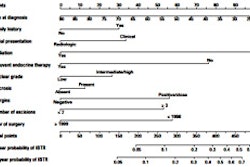
Eight months ago, the U.S. Preventive Services Task Force (USPSTF) issued new guidelines for screening mammography that included, among other recommendations, eliminating routine screening for women younger than 50 years and older than 74, and a change from annual to biennial screening for women ages 50 to 74.
The uproar from various professional societies such as the American College of Radiology (ACR), the American Cancer Society (ACS), and certain women's groups was tumultuous. Headlines, comments, and predictions about the effects of the guidelines reverberated throughout both scientific publications and the lay news media: "Countless American women will die needlessly from breast cancer," "Incredibly flawed," "Will have deadly effects for American women," "Shocking and unconscionable," "Deliberate decisions to trade women's lives for money."
Many voiced concerns that Medicare, Medicaid, and insurance companies would cease paying for screening mammography in women younger than 50 and for annual screening in women of other ages. In a poll published in the Annals of Internal Medicine, two-thirds of physicians reported that they would stop recommending routine mammograms to women ages 40 to 49 years, and they would advise women ages 50 to 74 years to have mammography every two years instead of annually.
Where does screening mammography stand eight months later? Have any of these dire predictions come to pass? It seems not. In fact, the U.S. Department of Health and Human Services (HHS) recently issued guidelines that require private health plans to cover mammography screening for women ages 40 and older, regardless of whether the screening was annual or biennial. Furthermore, HHS plans to mandate that patient co-payments and deductibles be eliminated.
The poll disclosing that two-thirds of clinicians would follow the new USPSTF recommendations was taken very soon after those recommendations were announced and prior to the avalanche of criticism that was levied against them. I suggest that the furor raised regarding the task force guidelines has changed the minds of many if not most physicians, in favor of rejecting these recommendations.
I recently addressed the Florida Obstetric and Gynecologic Society (FOGS) on the subject of mammography, and asked the members of the audience how many have changed their mammography advice to patients as a result of the USPSTF recommendations. Ninety percent responded that they have ignored them and not changed what they advise their patients.
This is, of course, a single sampling and certainly does not necessarily reflect the attitude of all obstetricians and gynecologists and other physicians in the nation. Nevertheless, my guess is that it does. I believe that the 2009 USPSTF recommendations relative to screening mammography will not be followed by the overwhelming majority of physicians, insurance companies, and state and federal governments.
It is true that in recent months the number of women undergoing screening mammography has decreased noticeably across the country. There is no hard data available that show whether this decrease is due to the task force recommendations, economic factors, or public concern about the effects of radiation received during mammography. My belief is that the downturn is exclusively the result of the current weak American economy, and as the economy improves, women will return for their annual screening mammography examinations.
The fact that controversy regarding the relative benefits and harms of mammography has long existed and has been exacerbated by the recent hullabaloo over the task force recommendations cannot be denied. I believe that the debate over the value of mammography that has emerged in the medical and lay communities has benefited physicians and the public alike.
Some have voiced concern that bringing the debate out into the open has confused women. I disagree. Sir William Osler once wrote: "Medicine is a science of uncertainty and an art of probability." One of the goals of physicians is to help individuals cope with uncertainty about health or disease, pointing out that instead of being a necessary evil, uncertainty is an opportunity for growth.
Undeniably, mammography is the best screening tool available today to detect early breast cancer, and mammography does save lives. But it is also undeniable that certain downsides, in particular, overdiagnosis -- i.e., the detection of histologic carcinomas that are nonlethal -- also exist. Although data indicating that screening mammography reduces breast cancer mortality clearly exceed data indicating that it does not, nonetheless, we must all continue to keep aware of new data and research studies on this topic as they become available.
An example is a recent article in the British Medical Journal that reviews breast cancer mortality trends from 1989 to 2006 among 30 European countries. Mortality figures varied widely among the countries, but in all cases, they are influenced in varying degrees by both screening and breast cancer treatment. Interestingly, Iceland, a small nation that performs biennial mammography screening, had the highest reduction of 44.5%. The second highest reduction was 35%, in the U.K., a nation that screens women once every three years.
Let the debate and controversy continue. We don't need to fear it. In the midst of such debate and controversy, women will continue to undergo -- and benefit from -- screening mammography.
By Leonard Berlin, MD
AuntMinnie.com contributing writer
August 19, 2010
Leonard Berlin, MD, is professor of radiology at Rush Medical College in Chicago and vice chair of radiology at NorthShore University HealthSystem, Skokie Hospital, in Skokie, IL. The opinions expressed in guest editorials are those of the author and do not necessarily reflect the views of AuntMinnie.com.
Related Reading
Will new HHS guidance improve mammography screening rates? August 10, 2010
HHS rules support earlier mammography, July 14, 2010
HHS proposes HIPAA changes, July 9, 2010
10,000-plus in U.S. die for lack of cancer screens: CDC, July 6, 2010
Mammography screening hard-hit by economic downturn, June 22, 2010
Copyright © 2010 AuntMinnie.com



















